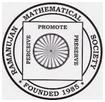 | |
| Formation | 1985 |
|---|---|
| Headquarters | Tiruchirappalli, Tamil Nadu, India |
President | Ravi S. Kulkarni |
| Website | http://www.ramanujanmathsociety.org/ |
Ramanujan Mathematical Society is an Indian organisation of persons formed with the aim of "promoting mathematics at all levels". The Society was founded in 1985 and registered in Tiruchirappalli, Tamil Nadu, India. Professor G. Shankaranarayanan was the first President, Professor R. Balakrishnan the first Secretary and Professor E. Sampathkumar the first Academic Secretary. The initial impetus for the formation of the Society was the deeply felt need of a new mathematical journal and the necessity of an organisation to launch and nourish the journal. [1] [2]
